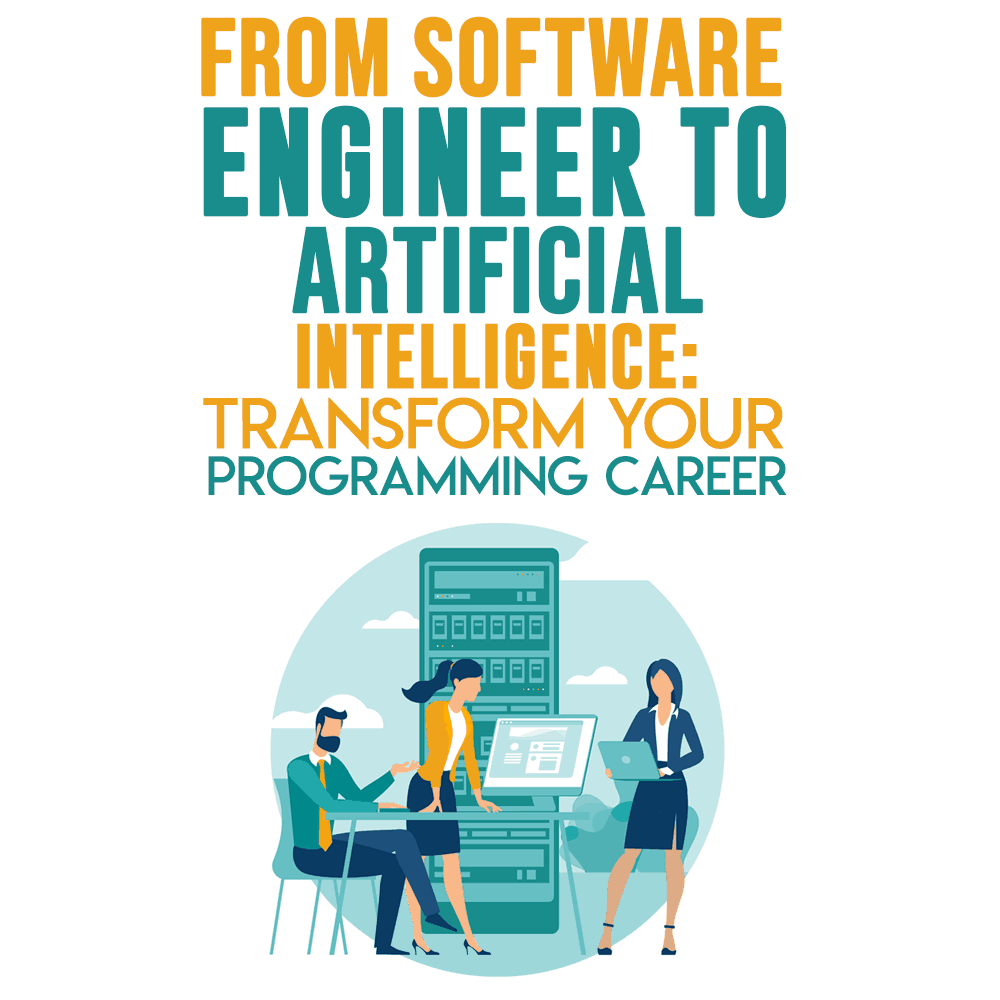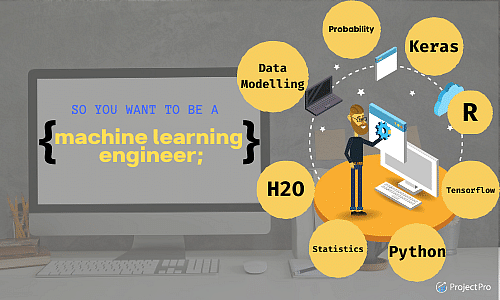All Categories
Featured
Table of Contents
- – The Best Strategy To Use For Machine Learning ...
- – Get This Report about Machine Learning & Ai Co...
- – Some Known Details About Top Machine Learning...
- – How Software Engineering For Ai-enabled Syste...
- – The Ultimate Guide To Machine Learning/ai En...
- – Things about Machine Learning/ai Engineer
- – The 5-Minute Rule for Top Machine Learning C...
Some individuals think that that's dishonesty. If somebody else did it, I'm going to use what that person did. I'm requiring myself to believe via the feasible solutions.
Dig a bit deeper in the math at the start, so I can construct that foundation. Santiago: Lastly, lesson number seven. This is a quote. It states "You need to comprehend every information of a formula if you wish to use it." And after that I state, "I think this is bullshit guidance." I do not believe that you have to recognize the nuts and screws of every formula before you use it.
I have actually been making use of neural networks for the longest time. I do have a feeling of just how the gradient descent works. I can not clarify it to you now. I would certainly have to go and inspect back to actually obtain a far better instinct. That does not indicate that I can not fix points using neural networks? (29:05) Santiago: Trying to force individuals to think "Well, you're not mosting likely to be successful unless you can clarify every single information of how this functions." It returns to our arranging example I believe that's just bullshit suggestions.
As an engineer, I have actually worked with numerous, many systems and I've utilized lots of, several points that I do not comprehend the nuts and bolts of just how it works, even though I understand the effect that they have. That's the last lesson on that particular string. Alexey: The amusing thing is when I consider all these libraries like Scikit-Learn the algorithms they utilize inside to implement, for instance, logistic regression or something else, are not the like the formulas we research in artificial intelligence courses.
The Best Strategy To Use For Machine Learning Engineer Course
So also if we attempted to find out to get all these fundamentals of maker knowing, at the end, the formulas that these collections utilize are various. ? (30:22) Santiago: Yeah, absolutely. I believe we need a lot much more materialism in the sector. Make a great deal even more of an effect. Or concentrating on delivering value and a little much less of purism.
I normally speak to those that want to function in the industry that desire to have their impact there. I do not dare to speak about that since I don't recognize.
Right there outside, in the industry, materialism goes a lengthy method for sure. Santiago: There you go, yeah. Alexey: It is a good motivational speech.
Get This Report about Machine Learning & Ai Courses - Google Cloud Training
One of the points I desired to ask you. First, let's cover a pair of points. Alexey: Let's start with core tools and frameworks that you need to learn to in fact change.
I recognize Java. I recognize exactly how to utilize Git. Maybe I know Docker.
Santiago: Yeah, absolutely. I think, number one, you ought to begin finding out a little bit of Python. Considering that you already recognize Java, I don't think it's going to be a huge transition for you.
Not because Python is the exact same as Java, but in a week, you're gon na obtain a great deal of the distinctions there. You're gon na be able to make some development. That's top. (33:47) Santiago: Then you get particular core devices that are mosting likely to be used throughout your entire career.
Some Known Details About Top Machine Learning Careers For 2025
That's a collection on Pandas for data control. And Matplotlib and Seaborn and Plotly. Those 3, or one of those 3, for charting and presenting graphics. You get SciKit Learn for the collection of equipment knowing algorithms. Those are tools that you're going to need to be making use of. I do not recommend just going and learning more about them unexpectedly.
We can discuss particular courses later. Take among those programs that are mosting likely to begin presenting you to some troubles and to some core ideas of artificial intelligence. Santiago: There is a course in Kaggle which is an introduction. I don't keep in mind the name, yet if you go to Kaggle, they have tutorials there for cost-free.
What's good concerning it is that the only need for you is to know Python. They're mosting likely to present a problem and tell you exactly how to utilize choice trees to resolve that specific trouble. I think that procedure is very powerful, because you go from no device finding out history, to understanding what the issue is and why you can not resolve it with what you recognize today, which is straight software design practices.
How Software Engineering For Ai-enabled Systems (Se4ai) can Save You Time, Stress, and Money.
On the other hand, ML engineers specialize in structure and deploying artificial intelligence models. They focus on training designs with information to make forecasts or automate jobs. While there is overlap, AI engineers deal with more varied AI applications, while ML designers have a narrower concentrate on artificial intelligence formulas and their functional implementation.

Artificial intelligence engineers concentrate on developing and deploying maker learning models into production systems. They deal with engineering, guaranteeing versions are scalable, efficient, and incorporated right into applications. On the other hand, information researchers have a wider function that includes information collection, cleansing, exploration, and building models. They are commonly in charge of drawing out understandings and making data-driven choices.
As companies progressively embrace AI and artificial intelligence innovations, the need for proficient professionals expands. Equipment knowing designers work with advanced projects, add to technology, and have competitive salaries. Success in this field requires continual learning and maintaining up with progressing technologies and techniques. Maker knowing duties are usually well-paid, with the potential for high gaining potential.
ML is basically various from traditional software program advancement as it concentrates on mentor computer systems to gain from information, instead of programs explicit regulations that are implemented methodically. Unpredictability of outcomes: You are possibly made use of to writing code with foreseeable outputs, whether your function runs as soon as or a thousand times. In ML, nonetheless, the results are less certain.

Pre-training and fine-tuning: Just how these designs are educated on large datasets and after that fine-tuned for specific jobs. Applications of LLMs: Such as message generation, sentiment evaluation and info search and access.
The Ultimate Guide To Machine Learning/ai Engineer
The capability to manage codebases, combine modifications, and settle problems is simply as crucial in ML advancement as it remains in standard software application jobs. The abilities established in debugging and testing software application applications are very transferable. While the context may transform from debugging application reasoning to identifying concerns in information processing or version training the underlying concepts of methodical examination, theory testing, and iterative refinement are the exact same.
Artificial intelligence, at its core, is heavily dependent on stats and possibility theory. These are essential for understanding exactly how formulas pick up from information, make forecasts, and examine their performance. You need to take into consideration ending up being comfortable with principles like analytical significance, circulations, hypothesis testing, and Bayesian reasoning in order to layout and interpret models effectively.
For those curious about LLMs, an extensive understanding of deep understanding architectures is useful. This consists of not only the mechanics of neural networks yet also the style of details models for different usage instances, like CNNs (Convolutional Neural Networks) for picture processing and RNNs (Persistent Neural Networks) and transformers for consecutive information and all-natural language processing.
You need to be mindful of these concerns and learn methods for determining, alleviating, and communicating regarding prejudice in ML designs. This consists of the possible influence of automated choices and the honest effects. Lots of versions, especially LLMs, require considerable computational resources that are usually provided by cloud platforms like AWS, Google Cloud, and Azure.
Structure these skills will certainly not just help with an effective change into ML however additionally make certain that designers can contribute properly and properly to the development of this dynamic area. Concept is necessary, however nothing defeats hands-on experience. Beginning servicing jobs that enable you to apply what you've learned in a practical context.
Join competitions: Join platforms like Kaggle to take part in NLP competitors. Build your tasks: Start with straightforward applications, such as a chatbot or a message summarization device, and gradually boost complexity. The field of ML and LLMs is rapidly developing, with new advancements and innovations arising on a regular basis. Staying updated with the most up to date research study and patterns is essential.
Things about Machine Learning/ai Engineer
Contribute to open-source projects or create blog posts regarding your discovering trip and projects. As you get experience, begin looking for opportunities to include ML and LLMs into your work, or seek new roles concentrated on these innovations.
Possible use cases in interactive software program, such as referral systems and automated decision-making. Recognizing unpredictability, standard statistical procedures, and likelihood distributions. Vectors, matrices, and their duty in ML algorithms. Mistake minimization strategies and slope descent described simply. Terms like design, dataset, functions, labels, training, inference, and recognition. Information collection, preprocessing techniques, version training, evaluation procedures, and deployment factors to consider.
Decision Trees and Random Forests: User-friendly and interpretable models. Assistance Vector Machines: Maximum margin category. Matching issue types with ideal designs. Balancing performance and intricacy. Standard framework of neural networks: neurons, layers, activation functions. Layered computation and ahead breeding. Feedforward Networks, Convolutional Neural Networks (CNNs), Frequent Neural Networks (RNNs). Photo recognition, sequence forecast, and time-series analysis.
Information flow, makeover, and feature design strategies. Scalability principles and efficiency optimization. API-driven approaches and microservices integration. Latency administration, scalability, and variation control. Continuous Integration/Continuous Implementation (CI/CD) for ML process. Version monitoring, versioning, and performance monitoring. Finding and addressing modifications in version performance in time. Addressing efficiency bottlenecks and source administration.
The 5-Minute Rule for Top Machine Learning Careers For 2025

You'll be presented to three of the most relevant parts of the AI/ML technique; overseen knowing, neural networks, and deep learning. You'll comprehend the distinctions between standard programs and device discovering by hands-on growth in supervised knowing before developing out intricate dispersed applications with neural networks.
This course functions as an overview to device lear ... Show More.
Table of Contents
- – The Best Strategy To Use For Machine Learning ...
- – Get This Report about Machine Learning & Ai Co...
- – Some Known Details About Top Machine Learning...
- – How Software Engineering For Ai-enabled Syste...
- – The Ultimate Guide To Machine Learning/ai En...
- – Things about Machine Learning/ai Engineer
- – The 5-Minute Rule for Top Machine Learning C...
Latest Posts
A Non-overwhelming List Of Resources To Use For Software Engineering Interview Prep
Jane Street Software Engineering Mock Interview – A Detailed Walkthrough
Best Free Online Coding Bootcamps For Faang Interview Prep
More
Latest Posts
A Non-overwhelming List Of Resources To Use For Software Engineering Interview Prep
Jane Street Software Engineering Mock Interview – A Detailed Walkthrough
Best Free Online Coding Bootcamps For Faang Interview Prep